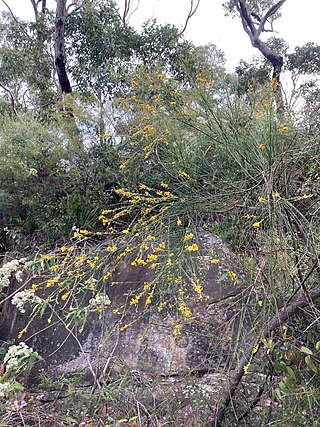
Viminaria juncea is the single species in the genus Viminaria endemic to Australia. The genus is in the pea family Fabaceae. It is colloquially known as native broom after its resemblance to the related European broom plants. The Noongar peoples know the plant as koweda.

Eriocaulon is a genus of about 400 species commonly known as pipeworts, of monocotyledonous flowering plants in the family Eriocaulaceae.

Westringia is a genus of Australian shrubs. As with other members of the mint family their upper petal is divided into two lobes. There are four stamens - the upper two are fertile while the lower two are reduced to staminodes. The leaves are in whorls of 3 or 4.

Romnalda is a genus of monocotyledonous plants in the family Asparagaceae, subfamily Lomandroideae. As of December 2013 four formally named species are known and accepted by botanical science.

Lechenaultia is a genus of flowering plants in the family Goodeniaceae, the species native to Australia with one species also occurring in New Guinea. Plants in the genus Lechenaultia are glabrous shrubs or herbs with needle-shaped leaves, more or less sessile flowers with five sepals and five blue, white, or yellow and red petals in two unequal lobes, the fruit an elongated capsule.

Orthrosanthus is a genus of flowering plants in the family Iridaceae first described as a genus in 1827. It is native to Australia, Mexico, Central and South America.
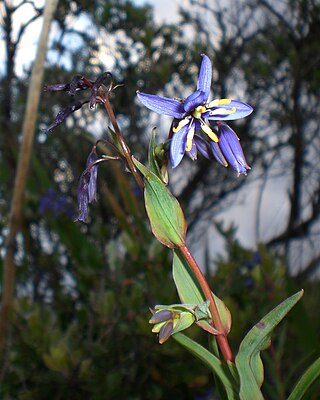
Stypandra is a small genus of rhizomatous perennials in the family Asphodelaceae, subfamily Hemerocallidoideae. They are native to Australia and New Caledonia.
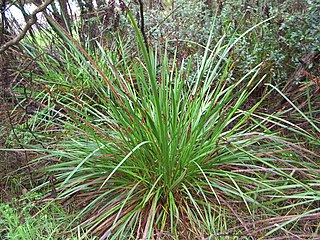
Lepidosperma is a genus of flowering plant of the family Cyperaceae. Most of the species are endemic to Australia, with others native to southern China, southeast Asia, New Guinea, New Caledonia and New Zealand.

Dichopogon is a genus of perennial herbs, native to Australia and New Guinea. It is included in the genus Arthropodium by some authorities, although recognized as a distinct genus by others. In the APG III classification system, it is placed in the family Asparagaceae, subfamily Lomandroideae.
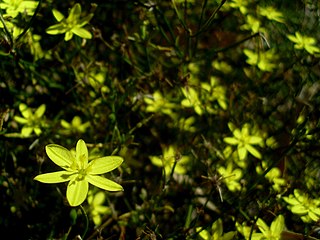
Tricoryne is a genus of perennial herbs in the family Asphodelaceae, subfamily Hemerocallidoideae. All species are native to Australia with two species extending to New Guinea; within Australia they occur in all 6 states and the Northern Territory.
- Tricoryne ancepsR.Br. - New Guinea, Queensland
- Tricoryne corynothecoidesKeighery - Western Australia
- Tricoryne elatiorR.Br. - Yellow Rush-lily - all 6 states plus Northern Territory
- Tricoryne humilisEndl. - Western Australia
- Tricoryne muricataBaker - Queensland
- Tricoryne platypteraRchb.f - New Guinea, Queensland
- Tricoryne simplexR.Br. - New South Wales
- Tricoryne tenellaR.Br. - Mallee Rush-lily - Western Australia, South Australia
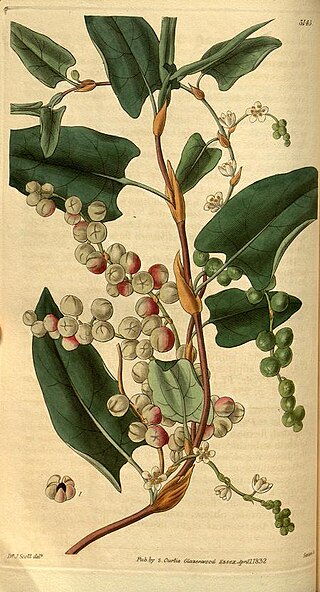
Muehlenbeckia adpressa, commonly known as climbing lignum, is a prostrate or climbing plant, native to Australia. It has thin red-brown stems up to 1 metre in length. The leaves are 1.5–6 centimetres (0.59–2.36 in) long and 1.5–3.5 centimetres (0.59–1.38 in) wide. It occurs in coastal areas of Western Australia, South Australia, Tasmania, Victoria and New South Wales.

Laxmannia is a genus of tufted perennial herbs in the family Asparagaceae, subfamily Lomandroideae, that are endemic to Australia.

Phaleria is flowering plant genus of about 25 species in the family Thymelaeaceae, which range from Sri Lanka to Malesia, Papuasia, northern and eastern Australia, and the tropical Pacific Islands.

Thelionema caespitosum, the tufted lily or tufted blue-lily, is a species of perennial herb, native to Australia. The lily-like flowers are blue, light blue, pale yellow or white and have yellow stamens.
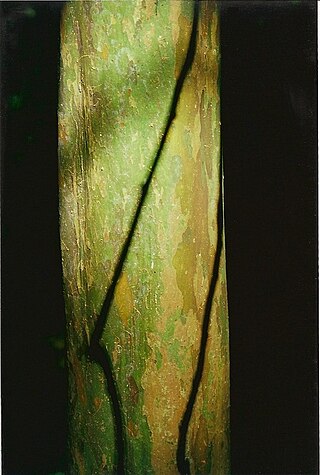
Gossia is a genus of rainforest trees in the myrtle family first described as a genus in 2003. It is native to northeastern Australia as well as several islands of Papuasia and New Caledonia.

Caustis is a genus of rhizomatous flowering plants in the sedge family.

Herpolirion is a genus of perennial herbs in the family Asphodelaceae, subfamily Hemerocallidoideae. The sole species is Herpolirion novae-zelandiae, commonly known as sky lily. It is native to New Zealand as well as the states of New South Wales, Victoria and Tasmania in Australia.
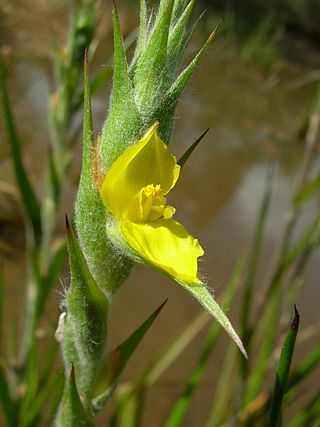
Philydrum is a genus of tufted, herbaceous, aquatic macrophyte plants, one of three genera constituting the plant family Philydraceae.
Wendlandia psychotrioides is a species of shrubs or small trees, constituting part of the plant family Rubiaceae.

Calectasia narragara, commonly known as a blue tinsel lily or star of Bethlehem, is a plant in the family Dasypogonaceae growing as a tufted rhizomatous herb. It is endemic to the southwest of Western Australia and common in most of its range.



















